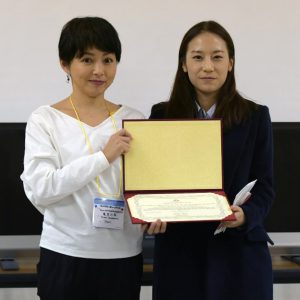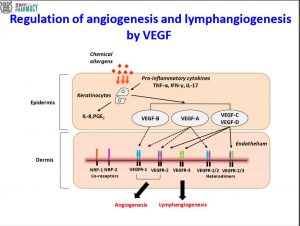JAVA、代替法研究費を助成
JAVA、初のアジア大会で代替法研究費を助成
韓国の若手研究者に
アジアンコングレス2016において、JAVAは若手研究者の代替法研究に15万円を助成しました。
選考の末、この「JAVA賞」を受賞したのは、韓国・ソウル大学校薬科大学のSae on KIMさんのグループ。
化粧品などのパーソナルケア用品では、アレルギーを引き起こす可能性があるかどうかのテスト(皮膚感作性試験)が行われていますが、この分野では、従来の動物実験のほか、代替法として採用されているのが、動物の苦痛軽減というRefinementに基づいた試験法であり、この試験では結局のところモルモットなど動物が使われています。
KIMさんらの研究では、動物をいっさい使わずに、ヒトの不死化角化細胞であるHaCaT ケラチノサイトを用いたアプローチを行っています。
新しい代替法の開発といっても、一朝一夕にできるものではありません。多くの時間とお金がかかります。動物実験の廃止への一助となるよう、JAVAもできる限りの研究支援を行っていきたいと考えています。


▼助成した研究プロジェクトの詳細▼
HaCaT ケラチノサイトにおける皮膚感作性試験代替法
生物指標としての血管内皮増殖因子(VEGF)の予備的評価
Sae on KIM
化粧品に警告表示や安全に使用するための注意書きがあるのはなぜか、疑問に思ったことはありませんか。化粧品などには、私たちの体にとって異物となる化学物質が含まれており、その多くは、肌に触れるとアレルギー反応を誘発する可能性があるからです。化粧品や歯磨き粉、石鹸などのパーソナルケア商品に含まれる金属成分によって発疹が出る人がいることはご存じだと思います。あるいは、特定のメイクアップ用品をつけた時だけかゆみを感じたり、つけた部分が熱を持ったりした経験のある方もいるでしょう。これらは、皮膚感作性と呼ばれる症状の代表的な例です。
皮膚感作性とは、特定の化学アレルゲン(アレルギー誘発物質)に繰り返し触れることで起きるアレルギー反応の一種で、化粧品、日焼け止め剤、家庭用品などの原材料に含まれる物質によって引き起こされることがあります。上記の商品に用いられている化学物質の多くは、使用量やそれに触れる度合い等にもよりますが、なんらかのアレルギー反応を誘発する可能性があります。アレルギー反応が起きるまでには、 感作相(かんさそう)(誘導相とも呼ばれます)と惹起相(じゃっきそう)のふたつの過程があります。感作相では、初めて化学アレルゲンと接触することで増感し、体に免疫記憶が形成されます。2番目の惹起相では、前に触れたことのある化学物質に再び触れることで、アレルギー性過敏症反応が誘発されます。
『化学品の分類および表示に関する世界調和システム(GHS) 』によると、皮膚感作物質の定義は、「臨床試験により、接触によるアレルギー反応誘発の可能性が証明できるもの」となっています。しかし、化学物質の皮膚感作性の有無を確認するために、動物実験が頻繁に行われています。潜在的な皮膚感作性を見極める方法として推奨され、実際に行われている方法として、局所リンパ節試験(LLNA)とモルモットマキシマイゼーション法(GPMT)があり、それぞれマウスとモルモットを使用します。動物への苦痛が軽減されてきているとはいえ、生体実験(in vivo)であることに変わりはありません。
私たちが研究している新しい皮膚感作性試験の代替法では、物質が生体にもたらすメカニズム(作用機序)に着眼し、血管内皮増殖因子(VEGF)を生物指標(バイオマーカー)としました。血管内皮増殖因子(VEGF)は、血管形成とリンパ管形成を調整する働きがあり、サイトカイン・ネットワークのインターロイキン-8(IL-8)に関係していることが分かっています。インターロイキン-8(IL-8)は、多様な免疫細胞によって作られるケモカインで、化学物質の潜在的な皮膚感作性を調べるための試験、インターロイキン-8ルシフェラーゼアッセイで使用されています。私たちは、16の代表的な化学感作物質が、正常ヒト初代表皮細胞(NHK)内における血管内皮増殖因子(VEGF)とインターロイキン-8(IL-8)の発現にどう作用するかを調べました。そして、16の化学感作物質のうち14が、正常ヒト初代表皮細胞(NHK)内の血管内皮増殖因子(VEGF)またはインターロイキン-8(IL-8)、あるいはその両方の値を著しく増加させることを発見しました。しかし、皮膚感作性の検証に、正常ヒト初代表皮細胞(NHK)を使用する方法には、限界があります。外的刺激や毒性刺激が異なると、正常ヒト初代表皮細胞(NHK)の生物学反応も変化するからです。この変化は、予備試験用に表皮組織を提供してくれたボランティアの人たち生物学的反応の違いからくるものです。
この可変性を補うため、正常ヒト初代表皮細胞(NHK)の代わりに、不死化角化細胞のHaCaT細胞を使えないか調べてみました。綿密に調べた結果、HaCaT細胞が、皮膚感作性が疑われる物質と刺激物に反応し、血管内皮増殖因子(VEGF)またはインターロイキン-8(IL-8)、あるいはその両方を作り出す事実を発見しました。皮膚感作性が疑われる物質と刺激物は、報告書や文献、『OECDテストガイドライン429』、欧州式光貼付試験をもとに選びました。HaCaT ケラチノサイト内で誘発した血管内皮増殖因子(VEGF)は少なかったものの、局所リンパ節試験では陰性だったヒト感作性物質の塩化ニッケルが、血管内皮増殖因子(VEGF)とインターロイキン-8(IL-8)の発現を大きく変化させました。
この研究により、血管内皮増殖因子(VEGF)とインターロイキン-8(IL-8)が、細胞を基盤としたモデルにおいて、化学物質が持つ潜在的な皮膚感作性の評価に、生物指標として使用できることが分かりました。私たちの研究が、科学分野の研究で使用される動物たちの苦痛の軽減(Refinement)、使用数の削減(Reduction)、そして代替法の採用(Replacement)の必要性に対する意識を高める一助になることを希望するとともに、私たちが手本を示すことで、皮膚感作性試験に、より多くの代替法が採用されることを願っています。

発表スライドより
Preliminary Evaluation of Vascular Endothelial Growth Factor as a Biomarker for Alternative Skin Sensitization Test in HaCaT Keratinocytes
Sae on KIM
Have you ever wondered why consumer products are provided with warning labels and directions for safe use? Chances are that many of the foreign chemicals found in such items are capable of inducing an allergic reaction upon skin contact. Perhaps, you have noticed that some individuals develop rashes from metals found in personal care products, or have experienced itching and burning sensation after applying certain types of makeup. These represent some common examples of what is known specifically as skin sensitization.
Skin sensitization is a type of allergic response that results as of repeated exposure to a particular chemical allergen, and can be induced by substances found as ingredients of cosmetics, sunscreens, household products, and more. Depending on the dose and extent of dermal exposure, many of the chemicals in use have, to some degree, the potential to induce an allergic reaction. The events leading up to this process occur in 2 phases, and comprises of sensitization (also referred to as induction) and elicitation. In the first phase, the initial contact with a chemical allergen generates a sensitization process, in which the individual develops immunological memory. Following, in the second phase, an allergic hypersensitivity response is elicited upon re-exposure to the same chemical sensitizer.
The Globally Harmonized System for Classification and Labeling of Chemicals (GHS) defines a substance as a skin sensitizer if there is clinical evidence indicating that it has the potential to cause an allergic response upon contact. Frequently, however, the method used to evaluate a chemical’s skin sensitization potential involves animal testing. Examples of some preferred and accepted methods for the assessment of skin sensitization potential include the Local Lymph Node Assay (LLNA) and Guinea Pig Maximization Test (GPMT), which involve the use of mice and guinea pigs, respectively. Although the assays have been refined to minimize harm to animals, they are still performed under in vivo conditions.
The main objective of our research was to discover a novel mechanism-based alternative method for testing skin sensitization using vascular endothelial growth factor (VEGF) as a biomarker. VEGF is involved in the regulation of angiogenesis and lymphangiogenesis, and is known to be associated with interleukin-8 (IL-8) in a cytokine network. IL-8 is a chemokine produced by various types of immune cells, and is used in the Interleukin-8 Luciferase assay to evaluate the skin sensitization potential of chemicals. In our study, we tested the effects of 16 referenced chemical sensitizers on the expression of VEGF and IL-8 in primary normal human keratinocytes (NHKs). We found out that 14 of the 16 chemical sensitizers significantly increased VEGF and/or IL-8 expression in NHKs. However, the use of primary human keratinocytes for skin sensitivity validation studies is limited. The biological responses of human keratinocytes to different external and toxic stimuli are generally variable, and this is due to differences in the biological responses amongst the volunteers that donate their epidermal tissue for the prevalidation studies.
In order to compensate for the variation, we evaluated the feasibility of HaCaT cells, immortalized human keratinocytes, as an alternative to primary human keratinocytes. Following a thorough investigation, we found out that HaCaT cells produced VEGF and/or IL-8 in response to potential skin sensitizers and irritants, which were selected based on reports in literature, OECD Test Guideline 429, and Scandinavian photo patch. Although fewer sensitizers induced VEGF production in HaCaT keratinocytes, nickel chloride, a human sensitizer resulting in a negative result using the LLNA method, significantly changed VEGF and IL-8 expression.
In this study, we found out that VEGF and IL-8 can be used as biomarkers to assess the skin sensitization potential of chemical substances in cell-based models. We hope that our work can increase awareness about the need for refinement, reduction, and replacement of animals in scientific research, and that we could possibly set an example for others to adopt more alternative methods for testing skin sensitization.
